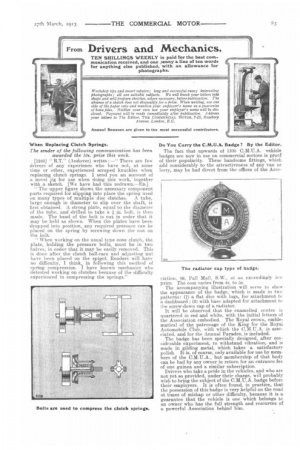From Drivers and Mechanics.
Page 23

If you've noticed an error in this article please click here to report it so we can fix it.
TEN SHILLINGS WEEKLY is paid for the best communication received, and one ,?enny a line of ten words for anything else published, with an allowance for photographs.
When Replacing Clutch Springs.
The sender of the following communication has been awarded the Ws. prize this week.
[1240] " R.T." (Andover) writes :—" There are few drivers of any experience who have not, at some time or other, experienced scraped knuckles when replacing clutch springs. I send you an account of a novel jig for use when doing this work, together with a sketch. [We have had this redrawn.—Enj "The upper figure shows the necessary component parts required for slipping into place the spring used on many types of multiple disc clutches. A tube, large enough in diameter to slip over the shaft, is first obtained. A strong plate, equal to the diameter of the tube, and drilled to take a g in. bolt, is then made. The head of the 'bolt is cut in order that it may be held as shown. When the plates have been dropped into position, any required pressure can be placed on the spring by screwing down the nut on the bolt.
"When working on the usual type cone clutch, the plate, holding the pressure bolts, must be in two halves, in order that it may be easily removed. This is done after the clutch ball-race and adjusting nut have been placed on the spigot. Readers will have no difficulty, I think, in following this method of spring compression. I have known mechanics who detested working on clutches because of the difficulty experienced in compressing the springs."
Do You Carry the C.M.I.J.A. badge? By the Editor,
The fact that upwards of 1100 C.M.U.A. vehicle badges are now in use on commercial motors is proof of their popularity. These handsome fittings, which add considerably to the attractiveness of any va,n or lorry, may be had direct from the offices of the Aso
elation, 89, Pall Mall. S.W., at an exceedingly low price. The cost varies from. 4s: to 5s.
The accompanying illustration will serve to show the appearance of the badge, which is made in two patterns: (1) a flat disc with lugs, for attachment to a, dashboard ; (2) with base adapted for attachment to the screw-down cap of a radiator. It will be observed that the enamelled centre is quartered in red and white, with the initial letters of the Association embodied. The Royal crown, emblematical of the patronage of the King for the Royal Automobile Club, with which the C.M.U.A. is associated, and for the Annual Parades, is included.
The badge has been specially designed, after considerable experiment, to withstand vibration, and is made in gilding metal, which takes a satisfactory polish. It is, of course, only available for use by members of the C.M.U.A., but membership of that body can be had by any owner in return for an entrance fee of one guinea and a similar subscription. Drivers who take a pride in the vehicles, and who are not yet so provided, under their charge, will probably wish to bring the subject of the C.M.U.A. badge before their employers. It is often found, in practice, that the possession of this badge is very helpful on the road at times of mishap or other difficulty, because it is a guarantee that the vehicle is one which belongs to an owner who has the full strength and resources of a powerful Association behind him.
























